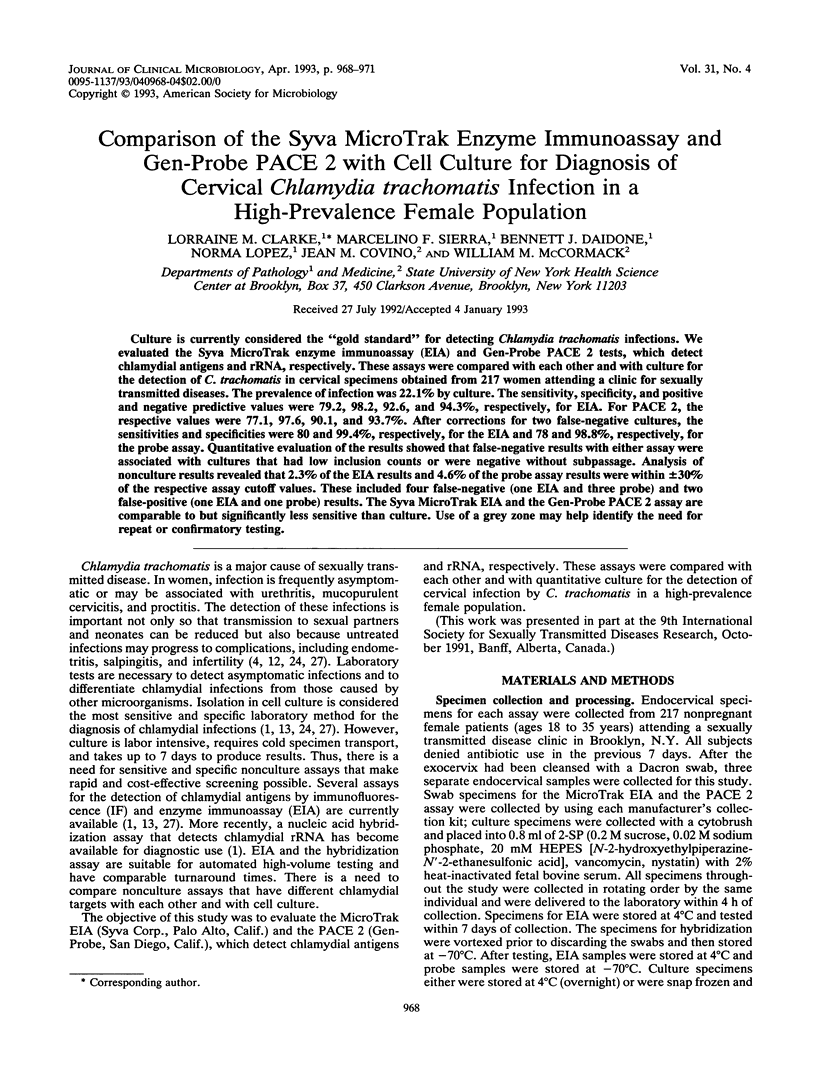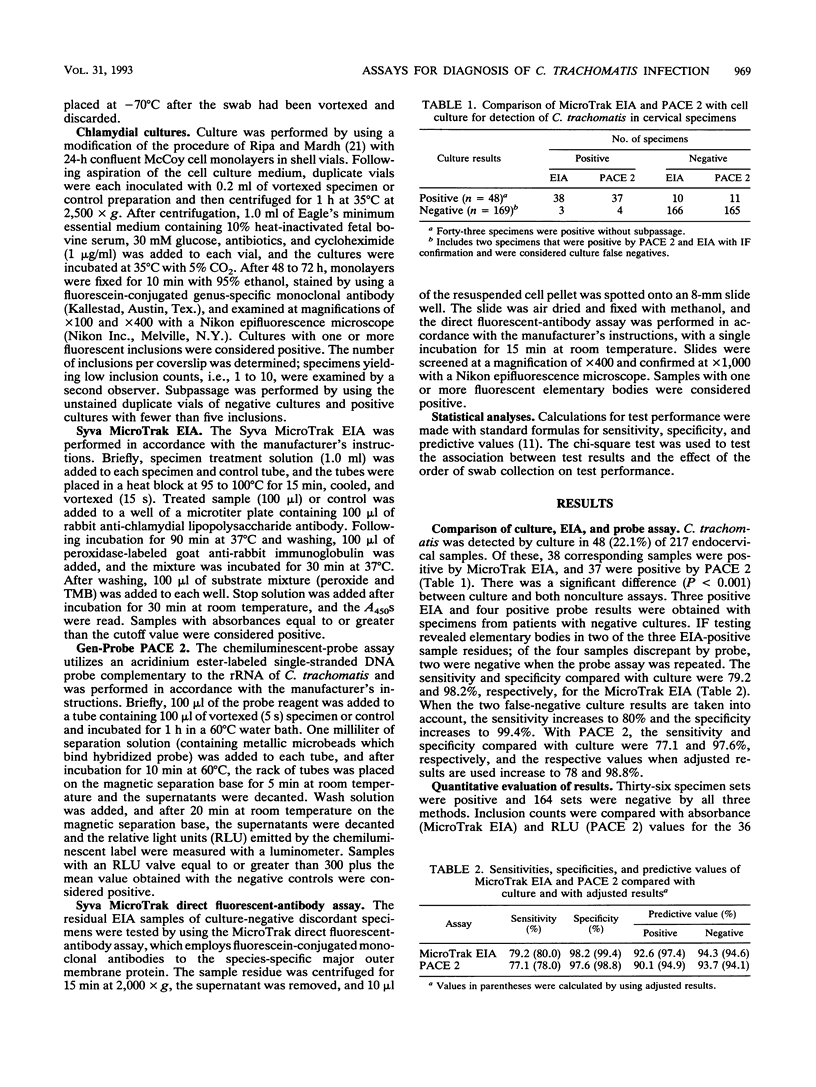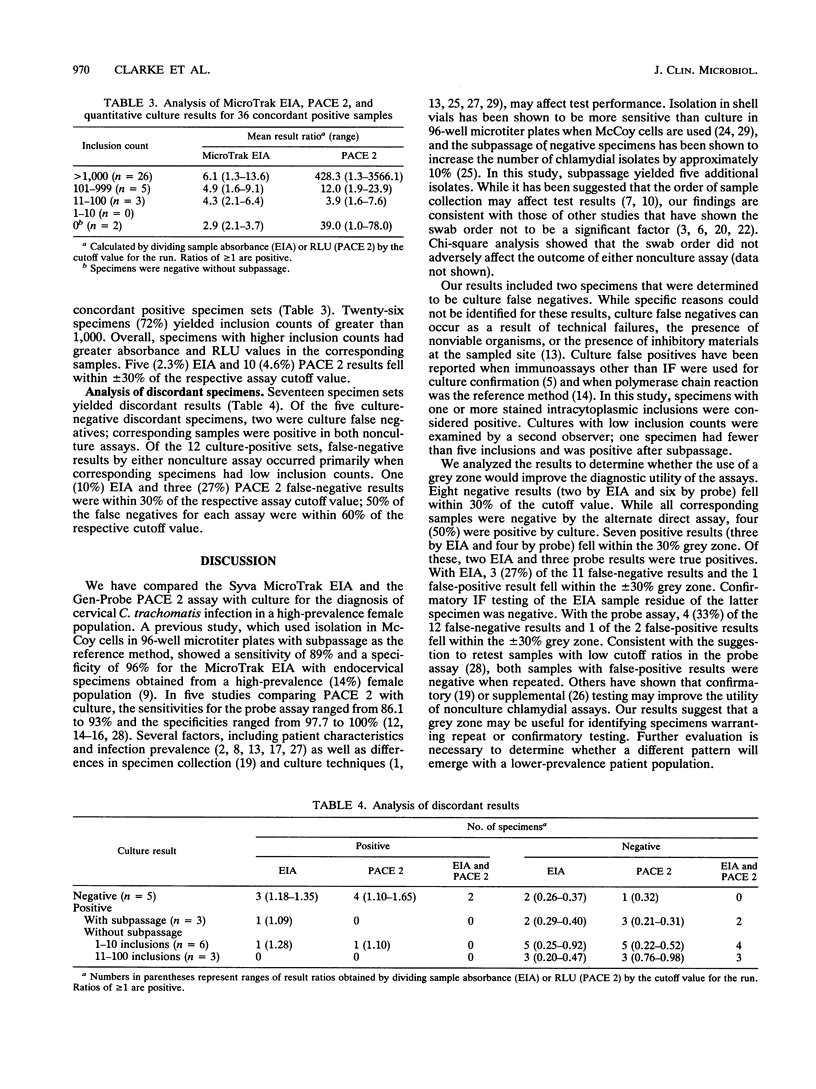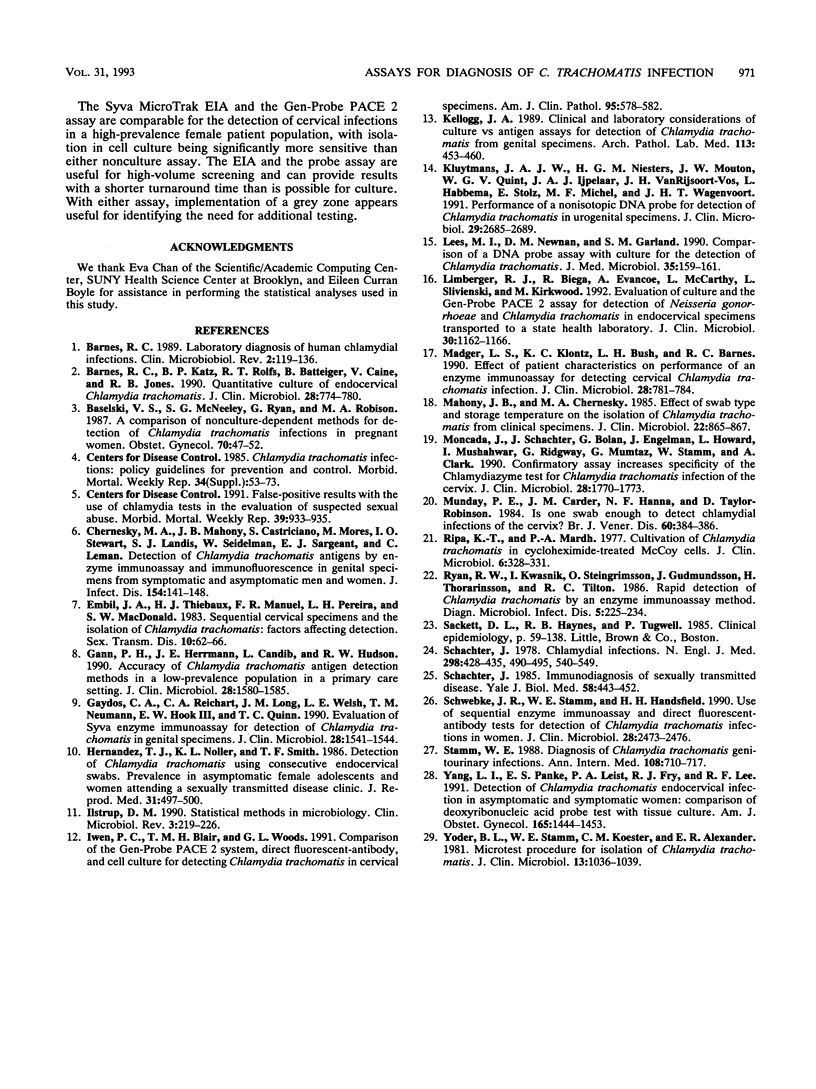Abstract
Culture is currently considered the "gold standard" for detecting Chlamydia trachomatis infections. We evaluated the Syva MicroTrak enzyme immunoassay (EIA) and Gen-Probe PACE 2 tests, which detect chlamydial antigens and rRNA, respectively. These assays were compared with each other and with culture for the detection of C. trachomatis in cervical specimens obtained from 217 women attending a clinic for sexually transmitted diseases. The prevalence of infection was 22.1% by culture. The sensitivity, specificity, and positive and negative predictive values were 79.2, 98.2, 92.6, and 94.3%, respectively, for EIA. For PACE 2, the respective values were 77.1, 97.6, 90.1, and 93.7%. After corrections for two false-negative cultures, the sensitivities and specificities were 80 and 99.4%, respectively, for the EIA and 78 and 98.8%, respectively, for the probe assay. Quantitative evaluation of the results showed that false-negative results with either assay were associated with cultures that had low inclusion counts or were negative without subpassage. Analysis of nonculture results revealed that 2.3% of the EIA results and 4.6% of the probe assay results were within +/- 30% of the respective assay cutoff values. These included four false-negative (one EIA and three probe) and two false-positive (one EIA and one probe) results. The Syva MicroTrak EIA and the Gen-Probe PACE 2 assay are comparable to but significantly less sensitive than culture. Use of a grey zone may help identify the need for repeat or confirmatory testing.
Full text
PDF



Selected References
These references are in PubMed. This may not be the complete list of references from this article.
- Barnes R. C., Katz B. P., Rolfs R. T., Batteiger B., Caine V., Jones R. B. Quantitative culture of endocervical Chlamydia trachomatis. J Clin Microbiol. 1990 Apr;28(4):774–780. doi: 10.1128/jcm.28.4.774-780.1990. [DOI] [PMC free article] [PubMed] [Google Scholar]
- Barnes R. C. Laboratory diagnosis of human chlamydial infections. Clin Microbiol Rev. 1989 Apr;2(2):119–136. doi: 10.1128/cmr.2.2.119. [DOI] [PMC free article] [PubMed] [Google Scholar]
- Baselski V. S., McNeeley S. G., Ryan G., Robison M. A comparison of nonculture-dependent methods for detection of Chlamydia trachomatis infections in pregnant women. Obstet Gynecol. 1987 Jul;70(1):47–52. [PubMed] [Google Scholar]
- Embil J. A., Thiébaux H. J., Manuel F. R., Pereira L. H., MacDonald S. W. Sequential cervical specimens and the isolation of Chlamydia trachomatis: factors affecting detection. Sex Transm Dis. 1983 Apr-Jun;10(2):62–66. doi: 10.1097/00007435-198304000-00003. [DOI] [PubMed] [Google Scholar]
- Gann P. H., Herrmann J. E., Candib L., Hudson R. W. Accuracy of Chlamydia trachomatis antigen detection methods in a low-prevalence population in a primary care setting. J Clin Microbiol. 1990 Jul;28(7):1580–1585. doi: 10.1128/jcm.28.7.1580-1585.1990. [DOI] [PMC free article] [PubMed] [Google Scholar]
- Gaydos C. A., Reichart C. A., Long J. M., Welsh L. E., Neumann T. M., Hook E. W., 3rd, Quinn T. C. Evaluation of Syva enzyme immunoassay for detection of Chlamydia trachomatis in genital specimens. J Clin Microbiol. 1990 Jul;28(7):1541–1544. doi: 10.1128/jcm.28.7.1541-1544.1990. [DOI] [PMC free article] [PubMed] [Google Scholar]
- Hernandez T. J., Noller K. L., Smith T. F. Detection of Chlamydia trachomatis using consecutive endocervical swabs. Prevalence in asymptomatic female adolescents and women attending a sexually transmitted disease clinic. J Reprod Med. 1986 Jun;31(6):497–500. [PubMed] [Google Scholar]
- Ilstrup D. M. Statistical methods in microbiology. Clin Microbiol Rev. 1990 Jul;3(3):219–226. doi: 10.1128/cmr.3.3.219. [DOI] [PMC free article] [PubMed] [Google Scholar]
- Iwen P. C., Blair T. M., Woods G. L. Comparison of the Gen-Probe PACE 2 system, direct fluorescent-antibody, and cell culture for detecting Chlamydia trachomatis in cervical specimens. Am J Clin Pathol. 1991 Apr;95(4):578–582. doi: 10.1093/ajcp/95.4.578. [DOI] [PubMed] [Google Scholar]
- Kellogg J. A. Clinical and laboratory considerations of culture vs antigen assays for detection of Chlamydia trachomatis from genital specimens. Arch Pathol Lab Med. 1989 May;113(5):453–460. [PubMed] [Google Scholar]
- Kluytmans J. A., Niesters H. G., Mouton J. W., Quint W. G., Ijpelaar J. A., Van Rijsoort-Vos J. H., Habbema L., Stolz E., Michel M. F., Wagenvoort J. H. Performance of a nonisotopic DNA probe for detection of Chlamydia trachomatis in urogenital specimens. J Clin Microbiol. 1991 Dec;29(12):2685–2689. doi: 10.1128/jcm.29.12.2685-2689.1991. [DOI] [PMC free article] [PubMed] [Google Scholar]
- Lees M. I., Newnan D. M., Garland S. M. Comparison of a DNA probe assay with culture for the detection of Chlamydia trachomatis. J Med Microbiol. 1991 Sep;35(3):159–161. doi: 10.1099/00222615-35-3-159. [DOI] [PubMed] [Google Scholar]
- Limberger R. J., Biega R., Evancoe A., McCarthy L., Slivienski L., Kirkwood M. Evaluation of culture and the Gen-Probe PACE 2 assay for detection of Neisseria gonorrhoeae and Chlamydia trachomatis in endocervical specimens transported to a state health laboratory. J Clin Microbiol. 1992 May;30(5):1162–1166. doi: 10.1128/jcm.30.5.1162-1166.1992. [DOI] [PMC free article] [PubMed] [Google Scholar]
- Magder L. S., Klontz K. C., Bush L. H., Barnes R. C. Effect of patient characteristics on performance of an enzyme immunoassay for detecting cervical Chlamydia trachomatis infection. J Clin Microbiol. 1990 Apr;28(4):781–784. doi: 10.1128/jcm.28.4.781-784.1990. [DOI] [PMC free article] [PubMed] [Google Scholar]
- Mahony J. B., Chernesky M. A. Effect of swab type and storage temperature on the isolation of Chlamydia trachomatis from clinical specimens. J Clin Microbiol. 1985 Nov;22(5):865–867. doi: 10.1128/jcm.22.5.865-867.1985. [DOI] [PMC free article] [PubMed] [Google Scholar]
- Moncada J., Schachter J., Bolan G., Engelman J., Howard L., Mushahwar I., Ridgway G., Mumtaz G., Stamm W., Clark A. Confirmatory assay increases specificity of the chlamydiazyme test for Chlamydia trachomatis infection of the cervix. J Clin Microbiol. 1990 Aug;28(8):1770–1773. doi: 10.1128/jcm.28.8.1770-1773.1990. [DOI] [PMC free article] [PubMed] [Google Scholar]
- Munday P. E., Carder J. M., Hanna N. F., Taylor-Robinson D. Is one swab enough to detect chlamydial infection of the cervix? Br J Vener Dis. 1984 Dec;60(6):384–386. doi: 10.1136/sti.60.6.384. [DOI] [PMC free article] [PubMed] [Google Scholar]
- Ripa K. T., Mårdh P. A. Cultivation of Chlamydia trachomatis in cycloheximide-treated mccoy cells. J Clin Microbiol. 1977 Oct;6(4):328–331. doi: 10.1128/jcm.6.4.328-331.1977. [DOI] [PMC free article] [PubMed] [Google Scholar]
- Ryan R. W., Kwasnik I., Steingrimsson O., Gudmundsson J., Thorarinsson H., Tilton R. C. Rapid detection of Chlamydia trachomatis by an enzyme immunoassay method. Diagn Microbiol Infect Dis. 1986 Sep;5(3):225–234. doi: 10.1016/0732-8893(86)90006-4. [DOI] [PubMed] [Google Scholar]
- Schachter J. Chlamydial infections (third of three parts). N Engl J Med. 1978 Mar 9;298(10):540–549. doi: 10.1056/NEJM197803092981005. [DOI] [PubMed] [Google Scholar]
- Schachter J. Immunodiagnosis of sexually transmitted disease. Yale J Biol Med. 1985 Sep-Oct;58(5):443–452. [PMC free article] [PubMed] [Google Scholar]
- Schwebke J. R., Stamm W. E., Handsfield H. H. Use of sequential enzyme immunoassay and direct fluorescent antibody tests for detection of Chlamydia trachomatis infections in women. J Clin Microbiol. 1990 Nov;28(11):2473–2476. doi: 10.1128/jcm.28.11.2473-2476.1990. [DOI] [PMC free article] [PubMed] [Google Scholar]
- Stamm W. E. Diagnosis of Chlamydia trachomatis genitourinary infections. Ann Intern Med. 1988 May;108(5):710–717. doi: 10.7326/0003-4819-108-5-710. [DOI] [PubMed] [Google Scholar]
- Yang L. I., Panke E. S., Leist P. A., Fry R. J., Lee R. F. Detection of Chlamydia trachomatis endocervical infection in asymptomatic and symptomatic women: comparison of deoxyribonucleic acid probe test with tissue culture. Am J Obstet Gynecol. 1991 Nov;165(5 Pt 1):1444–1453. doi: 10.1016/0002-9378(91)90388-8. [DOI] [PubMed] [Google Scholar]
- Yoder B. L., Stamm W. E., Koester C. M., Alexander E. R. Microtest procedure for isolation of Chlamydia trachomatis. J Clin Microbiol. 1981 Jun;13(6):1036–1039. doi: 10.1128/jcm.13.6.1036-1039.1981. [DOI] [PMC free article] [PubMed] [Google Scholar]


